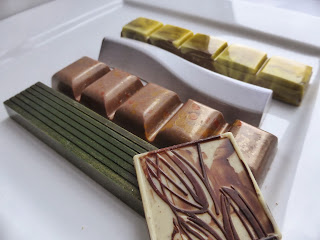Well readers, this is my final blog regarding a Savour class as this is the last day of my three month membership. But what a great class to finish on. Chocolate lollipops. A single bite of chocolate bliss. Or maybe two bites if you're dainty.
These little beauties were made using chocolate truffle shells, which are available in dark, white & milk chocolate. A variety of fillings were produced. Of the six varieties, five of them contain two layers. These fillings would also be suitable for a moulded chocolate.
So, starting from the purple lollipop & working clockwise, we have
- Kir Royale, which combines a blackcurrant caramel with a champagne ganache
- Coco kalamansi finds the sweetness of a white chocolate shell cut by the tartness of kalamansi
- Irish coffee sees the pairing of two ganaches, one flavoured with coffee & the other with Baileys
- Gia features hazelnut in both layers, a crunchy layer for texture & a smooth buttercream layer
- Popcorn finds an oozy salted caramel teamed with popcorn marshmallow- Lemon & coconut, in the centre, features a crunchy coconut component paired with a lemon ganache
Little or fairy penguins only live in Australia & New Zealand. They like rocky shorelines as these are the best sites for breeding & I imagine, the rocks would provide a degree of protection & security from predators & the elements. After feeding all day, each evening at dusk they venture onto the shoreline to take shelter amongst the rocks. They actually jump between the rocks & stumble often. Volunteers from Earthcare visit the pier each evening to give information to those viewing the penguins & ensure no one is impacting negatively on the colony. They also offer red cellophane to cover torches, as the penguins aren't able to see light in the red spectrum, so aren't disturbed by it. Flash photography is also banned. Apparently the light from torches & camera flashes affects them as they don't have eyelids & it may cause epileptic fits.



























































